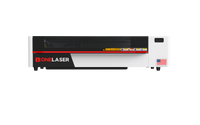Choosing the right laser nozzle is a critical step in achieving high-quality laser cutting and engraving results. While it may seem like a small component, the nozzle plays a significant role in determining cut precision, edge smoothness, and overall efficiency. In this article, we will break down how to select the optimal nozzle for your needs, with a focus on laser cutting nozzles, CO2 laser nozzles, and CO2 laser cutting nozzles.
1. Why the Laser Nozzle Matters
The laser cutting nozzle is positioned right at the output of the laser head, guiding both the laser beam and the assist gas (oxygen, nitrogen, or air) onto the material. A properly selected nozzle ensures:
- Stable cutting quality: Clean edges and minimal burrs.
- Optimal gas flow: Reduced turbulence, leading to smoother cuts.
- Efficient heat control: Prevents burning, especially in thin sheets.
- Optimal cut speed: The right nozzle improves gas flow efficiency, allowing faster cutting without sacrificing quality.
- Improved machine safety: Minimizes the risk of back-reflection or contamination.
Even a high-powered laser cannot perform at its best if the nozzle is unsuitable for the material or application.
2. Types of Laser Cutting Nozzles
Laser cutting nozzles can be classified in two main ways:
2.1 By Gas Flow Control (Layer Design)
- Single-layer nozzle: Best for oxygen cutting of carbon steel. Simple structure, stable flow. Not ideal for high-pressure nitrogen cutting.
- Double-layer nozzle: Ideal for nitrogen cutting of stainless steel and aluminum. Smooth, high-pressure gas flow for clean edges. Slightly more expensive.
- Special nozzles (ceramic, hybrid, etc.): Designed for high-precision or reflective materials. Extra durability, reduced reflection risk with higher cost.
For CO2 laser cutting nozzle setups, double layer nozzles are often preferred when working with stainless steel, while single layer nozzles remain the standard for mild steel cutting.
2.2 By Nozzle Shape (Tip Design)
- Standard conical nozzle: General-purpose cutting, cost-effective and easy to replace. Not ideal for ultra-thin or highly reflective materials.
- Focal point nozzle (small orifice): Concentrates gas flow for precision and clean edges. Requires careful alignment, prone to wear.
- Extended or shielded nozzle: Provides better gas protection, useful for thick plates or dirty environments. Slightly higher cost, may require adjustments to cutting parameters.
2.3 By Specialized Features
- Ceramic or hybrid nozzles: Reduce risks of back reflection damage, extend service life.
- Protective-coated nozzles: Enhanced resistance to contamination and wear in harsh cutting conditions.
These nozzle categories represent the available tool of options. The next step is to select the right one for your specific material, gas, and cutting requirements.
3. Key Factors for Selecting the Right Laser Cutting Nozzle
3.1 Material & Assist Gas (decides nozzle layers)
- Carbon steel + Oxygen → Single-layer nozzle
- Stainless steel / Aluminum + Nitrogen → Double-layer nozzle
- Highly reflective metals (Copper, Brass, Alloys) → Special nozzles
3.2 Cutting Requirements (decides nozzle shape)
- General-purpose cutting → Standard conical nozzle
- High precision / fine details → Focal point nozzle
- Thick plates / dusty environments → Extended or shielded nozzle
3.3 Nozzle Diameter (controls gas jet concentration)
- Small (0.8–1.0 mm): Thin sheets, fine detail cuts
- Medium (1.2–1.5 mm): Standard cutting jobs
- Large (2.0 mm+): Thick plates, high gas flow
3.4 Machine Compatibility
CO₂ laser nozzles are not always compatible with fiber machines → check specifications
3.5 Cost vs. Performance
- Single-layer + conical → most economical
- Double-layer + focal point → better quality, slightly higher cost
- Special nozzles → premium solutions for challenging materials
4. Nozzle Selection Guide
|
Factor |
Option |
Recommended Nozzle |
Reason / Application |
|
Material + Assist Gas |
Carbon steel + Oxygen |
Single-layer nozzle |
Stable flow, cost-effective for mild steel |
|
|
Stainless steel / Aluminum + Nitrogen |
Double-layer nozzle |
Stable high-pressure flow, smooth cut edges |
|
|
Copper, Brass (reflective metals) |
Special nozzles (ceramic/hybrid) |
Reduce reflection risk, improve durability |
|
Cutting Needs (Shape) |
General-purpose cutting |
Standard conical nozzle |
Universal, low cost, easy to replace |
|
|
Precision / fine edge quality |
Focal point nozzle |
Concentrated jet, minimal burrs |
|
|
Thick plates / dusty environments |
Extended / shielded nozzle |
Better protection, longer lifespan |
|
Nozzle Diameter |
0.8–1.0 mm |
Small nozzle |
Thin sheet cutting, fine details |
|
|
1.2–1.5 mm |
Medium nozzle |
Standard cutting tasks |
|
|
2.0 mm+ |
Large nozzle |
Thick plate cutting, high gas flow |
|
Machine Compatibility |
CO₂ laser |
CO₂-compatible nozzle |
Proper fit prevents leaks |
|
|
Fiber laser |
Fiber-compatible nozzle |
Ensures safe, stable performance |
|
Cost Balance |
Budget priority |
Single-layer + conical |
Best cost-performance ratio |
|
|
Quality priority |
Double-layer + focal point |
Higher quality cut |
|
|
Special applications |
Special nozzles |
For reflective or hard-to-cut materials |
5. Common Mistakes to Avoid
Even with the right machine and parameters, poor nozzle practices can lead to unstable cutting quality. Here are the most common mistakes and how to avoid them:
5.1 Using one nozzle for all jobs
- Different materials and thicknesses require different nozzle types, shapes, and diameters.
- A “one-size-fits-all” approach often results in rough edges, excess dross, or poor efficiency.
5.2 Ignoring nozzle wear
- Over time, nozzles become worn or deformed, leading to unstable gas flow and inconsistent cut quality.
- Regular inspection and timely replacement are critical for reliable performance.
5.3 Wrong alignment
- Even the best nozzle will not perform well if it is not centered properly with the laser beam.
- Misalignment causes asymmetrical gas flow, leading to burn marks, burrs, or incomplete cuts.
5.4 Over-replacing nozzles
- While worn nozzles must be replaced, changing them too frequently is also a mistake.
- Unnecessary replacements waste time, require re-alignment, and may damage threads or fittings.
- Instead, monitor nozzle condition carefully and only replace when wear clearly impacts cut quality.
5.5 Neglecting regular cleaning
- Spatter, dust, and oxidation can build up on the nozzle tip, disrupting gas flow and laser focus.
- Nozzles should be cleaned whenever visible debris accumulates, or after cutting highly reflective / coated materials.
- Use non-abrasive cleaning tools (soft cloth, alcohol wipes, or ultrasonic cleaning) to avoid scratching the nozzle surface.
6. FAQ
Q1: Can I use a CO2 laser nozzle for fiber cutting?
Not always. Fiber lasers require nozzles designed for high power density and anti-reflection coatings.
Q2: How often should I replace a laser cutting nozzle?
It depends on usage, but in general, after every few hundred hours of cutting—or sooner if you notice quality decline.
Q3: Does nozzle diameter really affect cut quality?
Yes. A mismatch between nozzle diameter, gas pressure, and material thickness often results in rough edges or incomplete cuts.
Conclusion
Selecting the right laser nozzle is not just a minor adjustment—it is essential for achieving high-quality cuts, maintaining efficiency, and protecting your laser equipment. By understanding nozzle types, material compatibility, and CO2 laser considerations, you can make an informed choice that maximize your machine’s performance and reduce production costs.
Whether you are using a standard laser cutting nozzle, a precision CO2 laser nozzle, or a specialized CO2 laser cutting nozzle, choosing wisely ensures cleaner cuts, faster processing, and a longer lifespan for your machine.
If you’re looking to upgrade or replace your nozzle, always consider your material type, cutting requirements, and machine compatibility. A well-chosen nozzle isn’t just an accessory—it’s the key to precision and productivity.

 Liquid error (sections/image-banner line 171): invalid url input
Liquid error (sections/image-banner line 171): invalid url input






